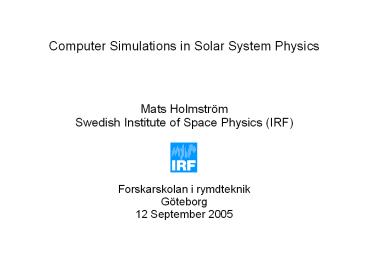Computer Simulations in Solar System Physics PowerPoint PPT Presentation
1 / 26
Title: Computer Simulations in Solar System Physics
1
Computer Simulations in Solar System Physics
- Mats Holmström
- Swedish Institute of Space Physics (IRF)
- Forskarskolan i rymdteknik
- Göteborg
- 12 September 2005
2
Solar System Physics and Space TechnologySSPT
Scientific Goals
Study the environment and the solar wind
interaction as well as the evolution and dynamics
of solar system objects with focus on the inner
planets, moons, asteroids, comets and dust.
Development of scientific instrumentation for
satellite-based measurements in support of space
exploration.
- How does the interplanetary medium affect and
shape the bodies in the inner solar system? - What plasma physical processes determine the
structure of the interaction regions? - How do the solar system dust population evolve
and interact with planetary bodies?
3
Overview
- The science we do
- The simulations we do. Some examples
- Ion precipitation at Mercury
- Instrument design
- Energetic neutral atom (ENA) production at Mars
- ENA production at the Moon
- Solar wind charge exchange X-rays at Mars
- Magnetohydrodynamics and particle simulations
4
(No Transcript)
5
Detectors of ...
- ... Ions, and
- ... Energetic Neutral Atoms (ENAs)
- Direction, flux, mass, energy/velocity
6
Current and Future Missions
7
Simulation Needs
- Proposals and Mission planning
- What is the sensor environment?
- What can we detect? What science can be done?
- Example Sputtered neutral atoms at Mercury
- Instrument design
- Optimization (performance-weight-power)
- Example Neutral atom detector for Mercury and
the moon - Data analysis
- Extract as much information as possible
- Example ENA production at Mars
8
Ion Trajectories
Example 1 Sputtered neutral atoms at Mercury
9
Ion Precipitation Map
Example 1 Sputtered neutral atoms at Mercury
10
Example 1 Sputtered neutral atoms at Mercury
The three columns correspond to, from left to
right, sputtering fromsolar wind protons, from
magnetotail accelerated protons, and fromsodium
photoions. The top row show maps of the ion
precipitation on Mercury's surface1/(cm2 s).
The subsolar point has zero longitude and
latitude. The bottom row shows the fluxes of
sputtered sodium atoms in theenergy range 10-40
eV as seen from a height of 400 km over areas of
large precipitation with a 160 degree field of
view. The unit is 1/(cm2 sr s)
11
Simulation Details
Example 1 Sputtered neutral atoms at Mercury
- C
- RKSUITE for the trajectory computationAdaptive
Runge-Kutta ODE solver - Parallelize the trajectory computations
- MPI for communication
12
Designing a Neutral Atom Imager
Example 2 Neutral atom detector for Mercury and
moon
- For missions to the moon and to Mercury
- Particle trajectories in the sensor by an MPI
application (A. Fedorov, CESR, France) - Optimize weight (dimensions) and mass resolution
13
Electric Potential
Example 2 Neutral atom detector for Mercury and
moon
14
Particle Trajectories
Example 2 Neutral atom detector for Mercury and
moon
15
Mass Resolution
Example 2 Neutral atom detector for Mercury and
moon
16
ENA Production at Mars
Example 3 ENA Production at Mars
- Generated by
- Solar wind-exosphere charge exchange
- Atmospheric sputtering and backscatter (of
precipitating ions and ENAs) - Planetary ions-exosphere charge exchange
- Solar wind-Phobos gas torus charge exchange
- Three-dimensional emissions
17
ENA imager Field of View at Mars
Example 3 ENA Production at Mars
Futaana, 2004
18
(No Transcript)
19
Interpreting ENA images at Mars
Example 3 ENA Production at Mars
- ENA flux Line of sight integration (ion flux
and neutral density) - Inverse problem(forward modeling)
20
ENA Production at the moon
Example 4 ENA Production at the Moon
- Generated by sputtering from
- Micro meteoroid impact vaporization
- Photon desorption
- Precipitating
- Magnetospheric ions
- Solar wind ions
- Significant contribution only from precipitating
solar wind ions - Two-dimensional emissions
21
Example 4 ENA Production at the Moon
Futaana, 2004
22
(No Transcript)
23
(No Transcript)
24
Solar Wind Charge Exchange X-rays
Example 5 SWCX X-rays at Mars
Observation
Simulations
25
The FLASH Code
Example 6 Magnetohydrodynamics and particle
simulations
- Magnetohydrodynamic (MHD) solver that can include
particles - From University of Chicago
- General compressible flow solver
- Adaptive (Paramesh) and parallel (MPI)
- Open source, Fortran 90
- Add boundary conditions and sources for solar
system objects - solar wind simulations(Mercury,
Venus, earth, moon, Mars, ...) - First investigations
- A comet (MHD with a photoion source)
- Mars' exosphere (particles)
26
Simulations is an integral part of our science

